#mongol army
Explore tagged Tumblr posts
Video
How The Mongol Empire Created The Most Feared Cavalry In History | Warri...
5 notes
·
View notes
Text


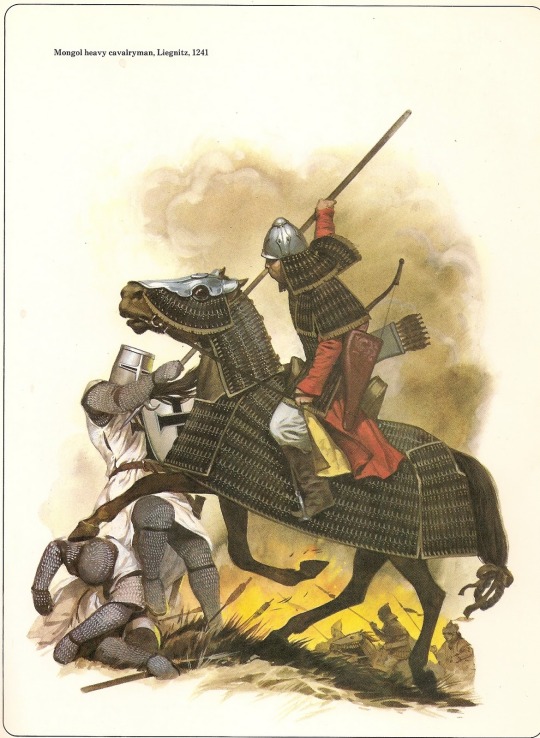


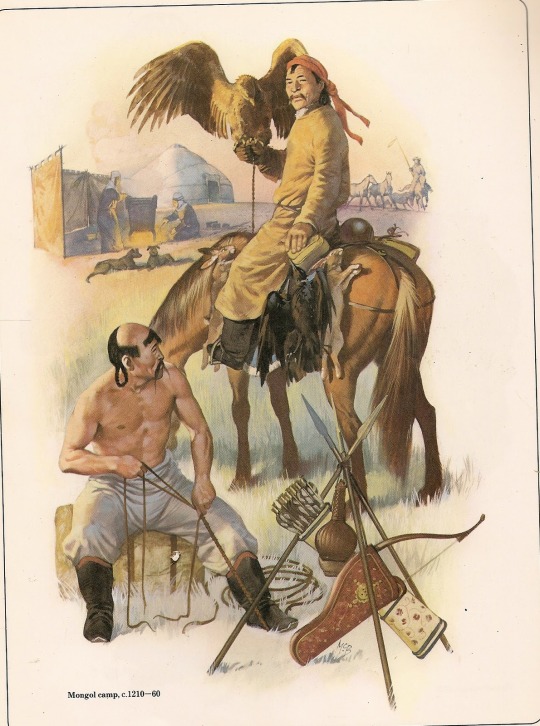


"NO ARMY HAS EVER PROVOKED SUCH JUSTIFIABLE TERROR AND LOATHING IN ITS VICTIMS..."
PIC(S) INFO: Spotlight on illustrations of the Mongol Army and the warrior culture that encapsulated the very nature of their empire, from the book "The Mongols" (1980), written by George Turnbull and illustrated by Angus McBride. Part of Osprey Publishing's "Men-At-Arms" Series, 105.
DESCRIPTION: "The history of the Mongol armies is a catalogue of superlatives. No armies in history have ever won so many battles or conquered so much territory. No army has ever provoked such justifiable terror and loathing in its victims, or slaughtered so many of its vanquished.
What other army in history has marched on Russia in the winter and survived, let alone won victories? The stories of these and many other amazing feats of this "barbarian" people are here brought vividly to life by Stephen Turnbull, from the birth of Genghis Khan in the wind-swept steppes of Mongolia, through the conquest of China and beyond."
-- OSPREY PUBLISHING, "The Mongols" (published 1980, "Men-At Arms" Series, 105)
Source: http://miniaturasmilitaresalfonscanovas.blogspot.com/2012/02/angus-mcbride-los-mongoles.html.
#The Mongols Osprey Publishing 1980#1980#The Mongols#Osprey Publishing#The Mongols 1980#Men-At-Arms Series#The Mongols Osprey Publishing#1980s#George Turnbull#Angus McBride Artist#Mongol Empire#The Mongol Empire#Osprey Publishing 1980#Illustration#Books#Angus McBride#Men-At-Arms#Men-At-Arms Series 1980#Mongol Army#Angus McBride Art#Military History#World History#Mongols#Central Asia
10 notes
·
View notes
Text
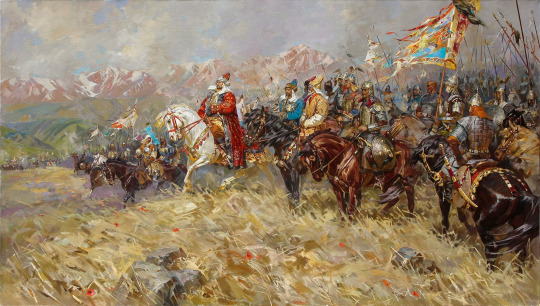
Riders on grassy hills -Art by Talgat Tleuzhanov
1 note
·
View note
Text
what i expected playing ghost of tsushima: fun saber combat with the parry/block/dodge system that i know and love
what i got playing ghost of tsushima: another protagonist tortured by war, turning himself into an one man army and being forced to give up the fighting code he was taught because he’s crushed by survivor’s guilt and feels like the entire world is on his shoulders
#i’d fight the entire mongol army with sticks for jin sakai#he deserves so much better#just like cal#that’s my type besties#i need to be careful with 3 letters named heroes because there’s only so many brainworms i can handle
4 notes
·
View notes
Photo

It sounded so much like emeralds duo dealing with the butcher army I had to draw it!
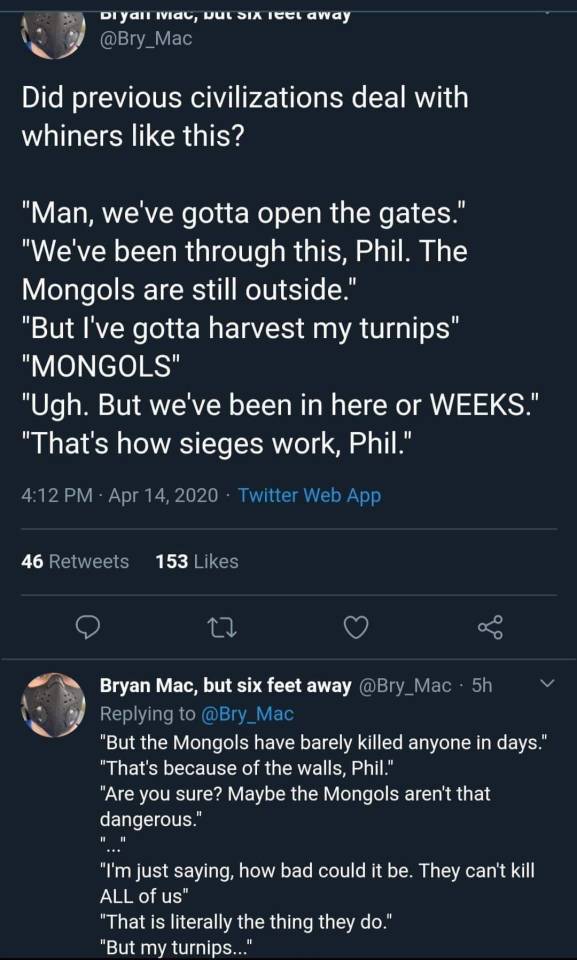
#Emerald duo#making techno pigsy themed was really fun lol#technoblade#philza#techno meme#technoblade fanart#philza fanart#butcher army#tubbo#ranboo#quackity#Turning mongol armor into aprons was an interesting challenge#dsmp#dream smp#Ctechno#cphilza#ctechnoblade#something to nom on
91K notes
·
View notes
Text




Zhangye 张掖 is a prefecture-level city in Gansu province, China. It borders Inner Mongolia on the north and Qinghai on the south.
Zhangye lies on the frontier of China proper, historically protecting it from the nomads of the north and permitting its armies access to the Tarim Basin. During the Han dynasty, Han armies were often engaged against nomadic people (e.g. the Xiongnu) in this area. It was also an important outpost on the Silk Road. Before being over-run by the Mongols, it was dominated by the Western Xia dynasty, and before that it was a vassal state for the Uyghurs.


The Yuan Dynasty’s founder (Genghis Khan’s grandson) Kublai Khan is said to have been born in Zhangye. Marco Polo's journal states that he spent a year in the region during his journey to China.
#china#🇨🇳#gansu#gansu province#zhangye#chinese#people’s republic of china#chinese culture#chinese heritage#chinese history#sino#yuan dynasty#han Dynasty#western xia#nature#Western xia dynasty#uyghurs#Uyghur history#dunhuang#lanzhou#marco polo#kublai khan#genghis khan#Mongol Empire#chinese architecture#mountains#desert#landscape#chinese landscape#Chinese nature
206 notes
·
View notes
Text
You know something that I’d like to see with the Illyrians? Clothes that actually fit the environment of the Illyrian Steppes. It’s described to be very cold, with brutal winds (duh it’s called Windhaven) but their battle armor just doesn’t really fit that? Even Nesta is like “yo I’m freezing where is the furs?” and Emerie is like “yeah it’s pretty expensive.” Yall, do you know how common hunting and furs would be? It would be a widely needed thing so maybe it’s more expensive if you’re not a hunter / you’re poor, but 1. They’re a warrior race in an isolated wilderness, they would for sure hunt, and 2. Clothes that fit the environment should be a pretty common thing instead of skin tight leathers. Skin tight leathers is crazyyyyyy when it’s that fucking cold. Like, yeah sure Cassian is like Illyrians are all about gritting your teeth and barring the cold, BUT I think your army dying of hypothermia might be important to avoid lmao. And when it comes to flying it can help, plus leather and furs is still light compared to other armor so I don’t think it would be too heavy for flying. They carry around a shit ton of metal weapons lmao.
And because I love visuals, I would love to see Illyrian leathers looking more like Mongol / Kazakhstan / Turkish, where weather is extreme and winters are very long and brutal.










#night court#Dana Pinterest / headcanons#Cassian ACOTAR#azriel acotar#Emerie ACOTAR#emerie of illyria#rhysand#rhysand acotar#ACOTAR#ACOTAR headcanons
165 notes
·
View notes
Text




Kalmyk dancers from the Soviet-era ensemble Tulpan in the city of Elista, Kalmyk Autonomous Soviet Socialist Republic, Russian SFSR
The state folk ensemble Tulpan was formed in 1937 in order to promote traditional Kalmyk music during the Soviet Unions - Korenizatsiia ("Indigenization") policy time period. During this point of Soviet history, the state sought to eliminate Russian political and cultural domination in regions where ethnic Russians were not a majority, in order to promote representation of Indigenous groups, and counter what they deemed as ethnic-Russian chauvinism and counter-revolutionary ("bourgeoise") nationalism among ethnic minorities. This policy was enacted in Ukraine, Central Asia, Moldova, the Baltics, southern Caucasus, and within Russia itself; including Kalmykia.
Korenizatsiia led to the establishment of the Kalmyk Autonomous Soviet Socialist Republic within Russia for the Kalmyk people, who are a Mongolic ethnic group from the steppes of European Russia.
During the interwar period, when Stalin was the leader of the USSR, Korenizatsiia was mostly abandoned. When the Nazis invaded Russia, including Kalmykia, around 5000 Kalmyks ended up collaborating with them in the Nazi-affiliated Kalmykian Cavalry Corps. This led to Kalmyks being deemed as enemies of the people, and to their collective deportation to Siberia and abolishment of the Kalmyk ASSR, despite the fact that 23k Kalmyks fought for the Red Army against the Nazis. In the 1950's Kalmyks were allowed to return to Kalmykia and the Kalmyk ASSR was reestablished.
#korenizatsiia#mongolic#oirats#kalmyks#kalmykia#russia#russian#eastern europe#eastern european#europeans#mongol#socialist#marxist#stalin#stalinism#lenin#soviet union#ussr#soviet#soviets#history#communism#communist#mongols#Республика Калмыкия#Калмы́ки#mongolian#Хальмгуд#Калмыки#kalmyk
115 notes
·
View notes
Text
[id: "Useless Bluehaired Pronoun Eunuchs" written in the style of the Teenage Mutant Ninja Turtles logo. end id.]
okay but the American education system literally didn't tell us how to defend against horse archers
#shield walls and counter-charges? fire those eunuchs. those are the tactics horse-arches exist to counter#you want to encircle them with light cavalry. use speed and manuevering to stop them and give a chance for your spearmen to move in#if their army is MOSTLY horse archers (aka the Mongols)... scorch the earth bog them down in sieges and try to invent gunpowder
59K notes
·
View notes
Text
eunuch rating system: part 2 electric boogaloo! part 1 based on the original post by @welcometothejianghu wherein i continue to rate REAL historical chinese eunuchs! this is a non-exhaustive list and there's honestly no metric to it. i just pick the guys i like.
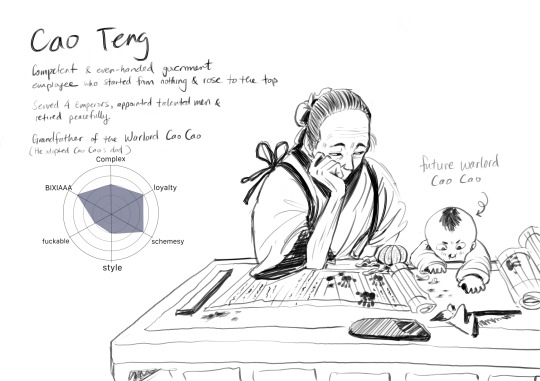
Han Dynasty (yes, again. the Han was like 400 years long lol) Cao Teng was a pretty normal guy whose biggest claim to fame is his extremely infamous grandson, Cao Cao. Because of this, Cao Teng is the only enunch in chinese history to get a royal title; Emperor Gao of Wei, which was granted posthumerously through Cao Cao’s grandson Cao Rui.
Cao Teng was a good judge of character who promoted a bunch of famous people, one of whom was a guy who had even tried to impeach him previously. After 30 years of service, he retired, got married, and adopted a son.
i decided to put him on the list because the common perception of the eunuch is a "mutilated" man living a lonely, unfulfilled life. What is often left out is they are highly motivated people who excel at their jobs, exert a lot of influence, and are able to have families and leave a legacy.
the majority of eunuchs came from poor families, and serving at the palace gave them an opportunity to obtain wealth, status and an education they would otherwise never have access to. it does require an unimaginably painful sacrifice, but that shouldn't be the only thing that defines them.
Cao Teng's hard work benefited his entire clan and lifted them out of poverty. But there was a complex interplay between him being a venerable ancestor, and someone marked by the stigma of castration. I imagine there was something bittersweet here for Cao Teng, knowing that he had done so much for his family, but they would rather he didn't exist.
Cao Cao was able to become a prime minister because of the wealth, connections, and education earned by his grandfather. At the same time, he appeared to resent him. The source of his ancestory was a sore spot which was repeatedly brought up by his political enemies to discredit him, something he never commented directly on or attempted to defend.
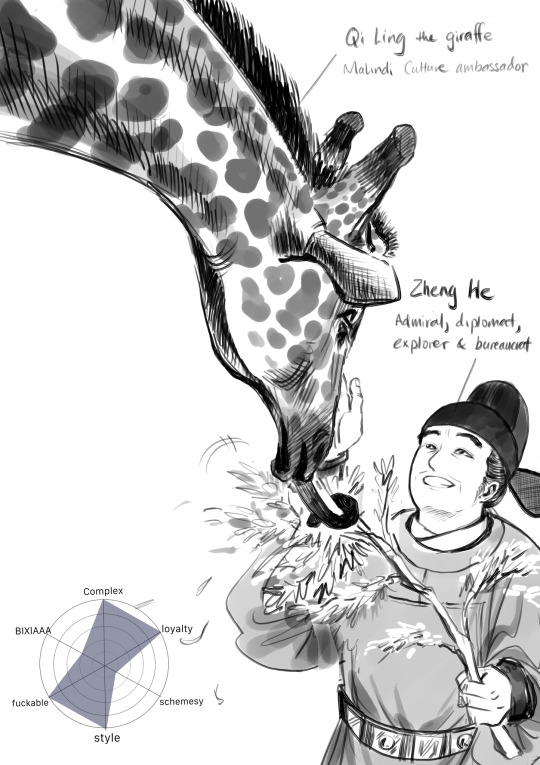
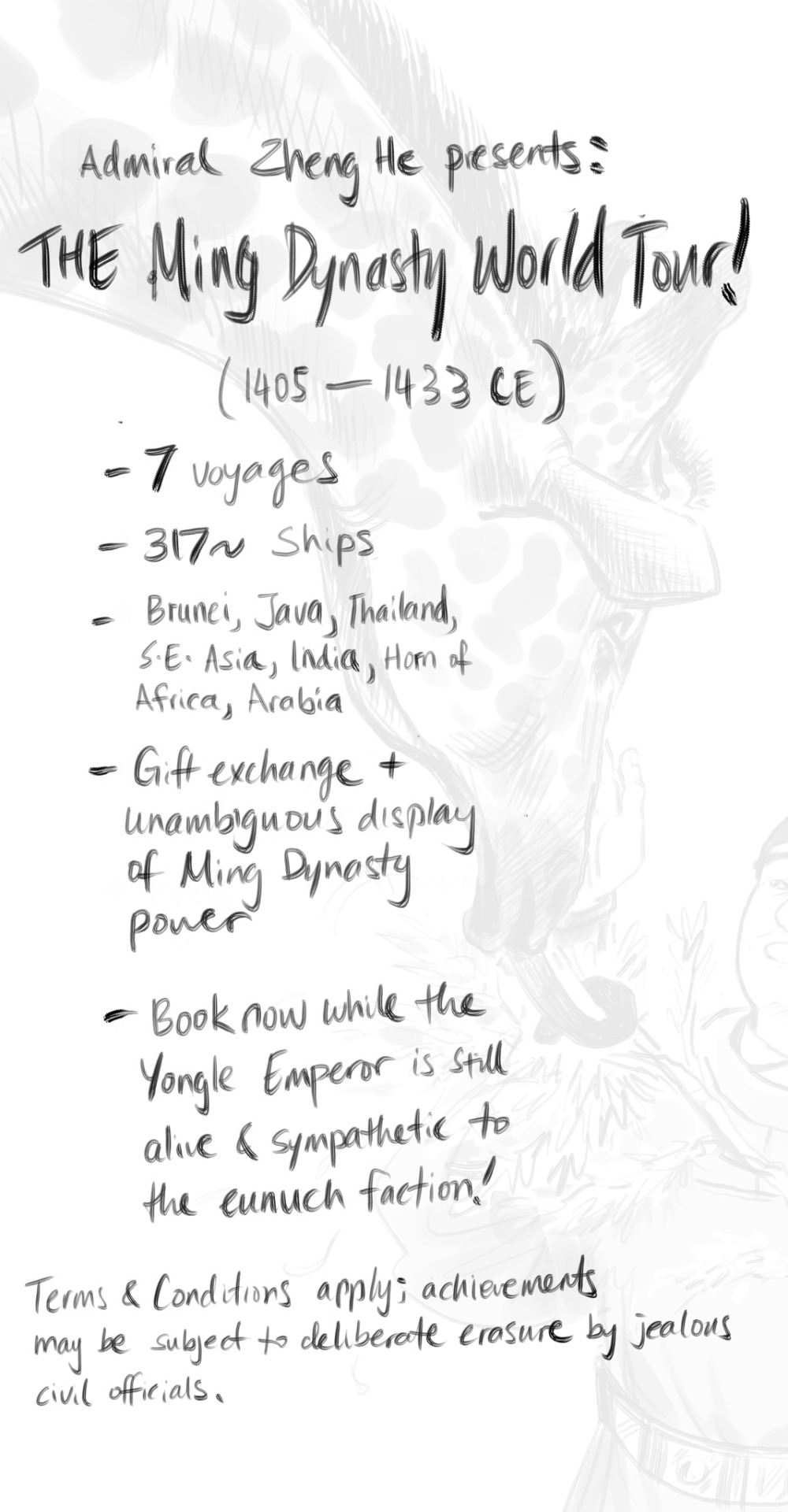
ming dynasty
MAKE SOME FUCKING NOISE FOR THE COOLEST PERSON IN THE MING DYNASTY!!!! actually scratch that, MAKE SOME FUCKING NOISE FOR THE COOLEST PERSON IN CHINESE HISTORY, PERIOD.
Zheng He was born Ma He to muslims living in Yunan, which was ruled by Mongols at the time. He was captured by the Ming army between the age of 10-14, castrated, and given to the young Yongle Emperor as a servant. Incredibly enough, he was like "no hard feelings mate" and went on to work in EVERY SINGLE JOB. and kick absolute ass in ALL OF THEM. he started out as a soldier on the northern frontier (the toughest place to serve, that was where all the border conflicts were) and fought in several campaigns with the future emperor, distinguishing himself and earning the emperor's trust.
I originally had him drawn in a more stereotypically "heroic" pose, by all accounts he was a tough guy who "walked like a tiger", and while the main purpose of the Ming voyages were diplomatic, he didn't shy away from violence. (he fought PIRATES. like a fucking shonen protagonist). in the end i decided to go with a picture that showcases less celebrated but equally important leadership qualities like curiosity, patience and discipline. I also want to point out that he wasn't the only eunuch on the trip, around half of the commanding officers were also eunuchs. He wasn't an exception to the rule but rather the face of a largely ignored majority; complicated people who were making the most of a difficult job.
Notes: the giraffe he brought back didn't have a name (at least not on record), but the Ming thought it was a qilin (kinda like a chinese unicorn) and i thought that would be an adorable name for a giraffe.
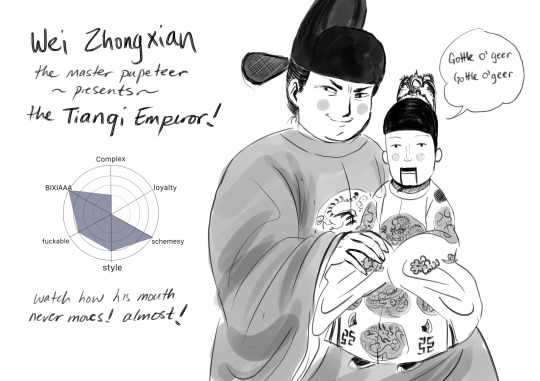

Ming Dynasty
i feel like we've had too much nuance, so lets finish this list off with a properly corrupt and scheming enunch! Wei Zhongxian castrated himself at age 21 to escape his gambling debts, and it unleashed his potiential like Rock Lee removing his leg weights. once inside the palace, he started out as a minor kitchen hand but managed to hustle his way to being the right hand of the emperor, who was an indifferent ruler that prefered woodworking to running a country. for this reason, I decided to make him a ventriloquist dummy.
Wei Zhongxian then proceeded to go on an extravagant and over-compensating ego trip. actually, it was more like a 40-year-long, olympic worthy, ego-long jump. things came to a terrible end when he tried to stage a coup (it failed and he decided not to hang around the capital, and go hang on some rafters instead). by then, decades of corruption had weakened the Ming, the emperor's only son got exploded in horrible incident that also wiped out most of the Ming Dynasty munitions--and what's this? here comes the Qing Dynasty with a steel chair!!!! notes: I decided to make Wei Zhongxian's design a human version of my cat, because he is also an incredibly devious but rather low-wisdom individial.
196 notes
·
View notes
Video
How The Mongol Empire Created The Most Feared Cavalry In History | Warri...
0 notes
Text
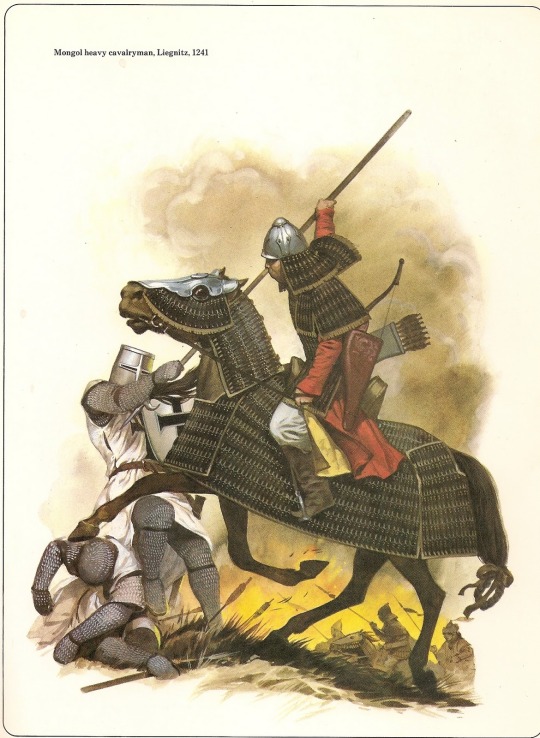
SPOTLIGHT ON THE SIGNIFICANCE OF HEAVY MONGOL CAVALRY IN BATTLEFIELD STRATEGY.
PIC INFO: Spotlight on a Mongol heavy cavalryman, Liegnitz (present day Legnica, Poland), c. 1241, the Mongol Empire. Artwork by the late, great Angus McBride.
OVERVIEW: "While a standard Mongol army did field a large number of horse archers, entire battles couldn’t be won by just one tactical arm of the force. In fact, almost equally (if not more) crucial was the Heavy Cavalry that was tailored to counter-attacking maneuvers. These heavy horsemen were mostly armored in Asiatic lamellar style where scales of metal (or hardened leather) were sewn together through tiny holes.
PART II: Sometimes entire coats were reinforced with metallic pieces – and they were possibly worn beneath dedicated armor systems for added protection, thus alluding to super-heavy cavalry units. Similarly, helmets were crafted from larger iron pieces, but they characteristically featured extended neck guards made of metallic bits. And as for arms, most of these heavy horsemen used lances, possibly both in couched and overhead positions."
-- REALM OF HISTORY (Dattatreya Mandal, February, 10, 2016)
Source: http://miniaturasmilitaresalfonscanovas.blogspot.com/2012/02/angus-mcbride-los-mongoles.html.
#Mongol Cavalry#The Mongols#Mongols#Mongol Warfare#Heavy Cavalryman#Osprey Publishing#Angus McBride Art#Mongol Empire#Mongol Heavy Cavalry#Mongol Heavy Cavalryman#Leignitz#Heavy Cavalry#Mongol Army#Legnica#Legnica Poland#Mongol Warfare History#Military History#Mongol Empire 1241#Angus McBride#The Mongol Empire#Cavalryman#Illustration#World History#The Mongols Osprey Publishing#1200s#Mongol Invasion of Europe#1241 A.D.#1241#Central Asia#Mongol Cavalryman
7 notes
·
View notes
Text
25 Medieval Women Who Ruled

The Middle Ages saw countless powerful women who defied expectations and ruled in their own right, whether as queens, empresses or khatuns. Some wielded power through diplomacy, others led armies into battle, and many fought against rivals who sought to undermine their rule. From Byzantine empresses who shaped imperial policy to Mongol regents commanding vast empires and European queens navigating war and succession crises, these women left lasting legacies. Here are 25 medieval women who ruled, proving that leadership was never exclusive to men.
85 notes
·
View notes
Text
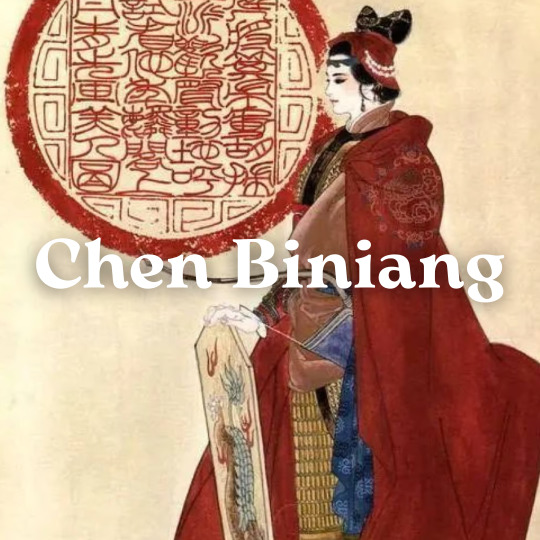
"Chen Biniang, d. 1279 (Southern Song dynasty), of Chaozhou (in the east of present-day Guangdong Province) is remembered for her loyalty and the patriotic sentiments she expressed in her poem “Farewell to My Husband” (Ci lang xing). After years of resistance, in 1276 the Southern Song court finally capitulated to the Yuan dynasty (1271–1368) when the Mongol armies of Qubilai Khan (1215–1294) captured the capital, Lin’an (present-day Hangzhou, Zhejiang Province). Remnants of the imperial family sought refuge elsewhere and by 1278 had fled to various places in Guangdong and nearby Kowloon, including present-day Kowloon City on Kowloon Peninsula, Hong Kong, where a monument to the events of that time still stands.
Chen Biniang and her husband, General Zhang Da (d. 1279), were among those who accompanied the eight-year-old last emperor of Southern Song, Di Bing (r. 1278–1279). When she and her husband parted at Haizhou (in present-day Guangdong Province), Chen Biniang wrote the poem for which she is remembered, here translated by Lily Xiao Hong Lee, encouraging him to remain loyal in the face of almost certain death and to staunchly defend the child emperor, giving no thought to the fate of his loved ones:
My husband, you have in your bosom the king of Song, You bid me farewell to pursue the journey by the boundless sea. There are traitors and wicked men but I will resist them. Behold my sword with its frosty blade. Once you begin your journey, don’t look back. The north wind whistles through the trees at Humen. The order is to pacify the road along Chaozhou. When you have recovered the Central Plains, announce it to the nation. You have a life, pledge it to the nation; Only by forgetting your home can you avenge the nation. I have a life, I pledge it to you. Don’t say that because a woman like me is with the army, It diminishes the army. I wish I could wash away the opposition to women’s aspirations,
A thousand years of it. Shed blood, not tears. I urge your horse forward, saying good-bye at the boat, If the shame of our nation could be eradicated, What more could I ask?
It seems from this that, during the last stage of his struggle, Chen Biniang did not accompany her husband and his army because of the traditional belief that the presence of a woman would be counterproductive. However, it also seems to imply that up until that time she had been with him. The place where they parted may have been Chaozhou, which was somehow mistaken as Haizhou: Haizhou was in Jiangsu Province, north of the Southern Song capital of Lin’an, while Chaozhou was on the coast of Guangdong Province. Mention in this poem of Chaozhou and Humen, both of which were in Guangdong, makes it more likely that they said farewell in Chaozhou.
From Kowloon, the boy emperor’s court moved to Yamen in present-day Donghuan, also in Guangdong. It is said that over 100,000 Mongol and Chinese soldiers perished during the three-week-long Battle of Yamen (Yamen zhanyi) in March 1279. The Chinese were defeated, and the boy emperor is believed to have drowned, possibly in the arms of a loyal minister. It is assumed that, as Southern Song collapsed, Chen Biniang and her husband also died during the fighting."
Zheng Bijun, Li Guotong, "Chen Biniang", in: Lee Lily Xiao Hong, Wiles Sue (eds.), Biographical Dictionary of Chinese Women, Volume II: Tang Through Ming 618 - 1644
#chen biniang#history#women in history#13th century#women's history#historyedit#warrior women#women warriors#female poets#female authors#feminism#china#chinese history#asian history#song dynasty#yuan dynasty
61 notes
·
View notes
Text
The Russian winter will kill you argument isn't even the thing. I mean, it will, Russia isn't even uniquely fucked up there, but it's also way harder than that. On the topic of weather there is a mud season which massively slows down vehicles. Russia is also absurdly big. Its the biggest country on earth and has a surface area that contends with Pluto. It is practically impossible to occupy.
Oh and there are Russians there.
If the average Tumblr user was into military history, half of this website would vehemently argue that they could totally invade Russia in the winter.
#few armies if any invaded Russia in winter#they invaded at a normal time and unsurprisingly couldn't get it done in time before winter happened#also the mongols didn't exactly invade Russia#they invaded Kievan Rus and then invented Russia
3K notes
·
View notes
Photo

Ilkhanate: A Mongol Legacy in the Middle East
The Ilkhanate, established by Mongol general Hulegu in 1260 CE, was a key part of the Mongol Empire, spanning modern-day Iran, parts of Turkmenistan, Turkey, Iraq, Armenia, Afghanistan, and Pakistan. Hulegu received the title ilkhan, meaning viceroy, from his brother Mongke Khan, the ruler of the Mongols. This vast territory played a significant role in regional dynamics, often finding itself at odds with neighboring states.
Foundation and Early Years
Hulegu used an army granted to him by Mongke Khan to consolidate Mongol control in western Asia. He successfully defeated the Nizari Ismailis and the Abbasid Caliphate, capturing Baghdad in 1258 CE. However, his campaigns were halted after the death of Mongke in 1260 CE, and he withdrew to focus on holding Persia, marking the beginning of the Ilkhanate.
Rivalries and Conflicts
The Ilkhanate faced constant battles against the Chagatai Khanate, the Golden Horde, and the Mamluk Sultanate of Egypt. Notable conflicts include the defeat at the Battle of Terek in 1262 CE by the Golden Horde and military victories such as Abaqa's defeat of Baraq, ruler of the Chagatai Khanate, in 1270 CE.
Muslim-Christian Relations
Despite early rulers favoring Christianity, Islam became increasingly dominant. Ahmad Teguder was the first ilkhan to convert to Islam in 1282 CE. Later, Ghazan also converted, turning the Ilkhanate into a officially Muslim state in 1295 CE. This shift led to the destruction of many non-Muslim places of worship.
Economic Challenges and Decline
Economic instability plagued the Ilkhanate due to dynastic disputes and ill-advised policies like the introduction of paper money. Ghazan stabilized the economy with new coinage but could not prevent the ongoing decline. The state disintegrated in 1335 CE following the death of Abu Said and a series of power struggles, eventually being absorbed into the Timurid Empire.
Timeline Highlights:
1260-1335 CE: Ilkhanate period
1265 CE: Hulegu's death, succeeded by Abaqa
1270 CE: Abaqa defeats Baraq at the Battle of Herat
1295-1304 CE: Ghazan rules, converting to Islam
1304-1316 CE: Oljeitu rules, adopting Shiite Islam
1316-1335 CE: Abu Said's reign
1335 CE: Ilkhanate disintegrates into smaller states
Learn More
The above summary was generated by AI using Perplexity Sonar. To read the orginial human-authored article, please visit Ilkhanate.
42 notes
·
View notes